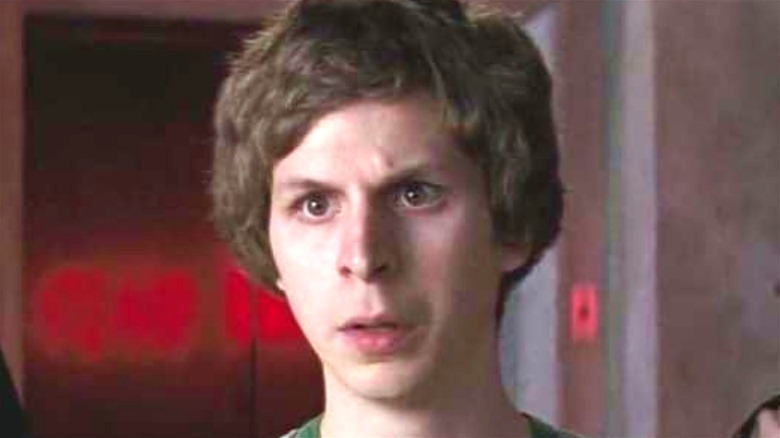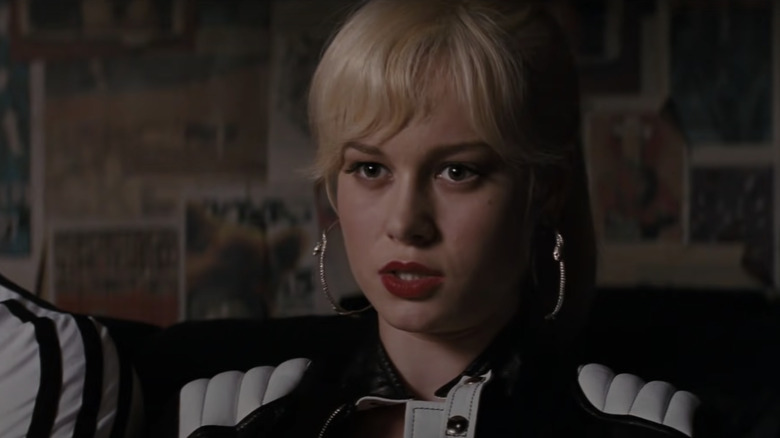The Subtle Character Detail You Never Noticed In Scott Pilgrim Vs. The World
"Scott Pilgrim vs. The World" is often regarded by gaming fans as being one of the best video game films ever made, despite not actually being an adaptation of a pre-existing game. Based on the "Scott Pilgrim" graphic novels by Bryan Lee O'Malley, the film adaptation follows its titular nerdy hero (played by Michael Cera), an underachieving musician, as he battles his new girlfriend Ramona Flowers' (Mary Elizabeth Winstead) seven evil exes in video game-style fights all while attempting to score a record deal with his band Sex Bom-Omb.
Cera and Winstead were joined in the film by the equally talented Kieran Culkin as Wallace Wells, Anna Kendrick as Stacey Pilgrim, Brie Larson as Envy Adams, Aubrey Plaza as Julie Powers, Alison Pill as Kim Pine, Ellen Wong as Knives Chau, Chris Evans as Lucas Lee, and Jason Schwartzman as Gideon "G-Man" Graves. Together, they and several other notable stars form the film's truly impressive ensemble cast.
While "Scott Pilgrim vs. The World" is usually praised for its stunning visual style and amazing special effects, it's also masterful in how it uses and brings its various, often eccentric characters to life. In fact, there's an especially subtle technique that director Edgar Wright used to help make each character better fit within the heightened, video game-inspired aesthetic of the film.
Don't blink!
10 years after "Scott Pilgrim vs. The World" was originally released in 2010, the cast reunited virtually for a charity table read, which began with Anna Kendrick jokingly asking if they were allowed to blink. While it may have seemed like a random question at the time, it turns out there's actually a bigger story behind it. Indeed, just a few months prior to the virtual cast reunion, director Edgar Wright tweeted a fun fact about the film, writing, "I made @brielarson do all her scenes without blinking to make it seem more 'anime'. And got the nickname The Blink Nazi."
Wright further expanded on the no-blinking rule in an interview with Rotten Tomatoes, explaining, "I wanted it to feel very kinda surreal, like a bit like [an] anime, and in animation, people don't really blink so much." The director went on to admit that the decision was also partly inspired by a famous piece of acting advice he'd heard before making the film. "There's a thing like [with] Michael Caine, his school of acting, page one was like, 'Never blink on a close-up. It disempowers you and it makes you look weak.' And it's true! It's like, if somebody doesn't know their lines, they're blinking like crazy," Wright revealed. "So I sort of thought it was a good thing in this because if you look at like Brie Larson's performance particularly, she's so strong and so unblinking. So we got into this thing of not blinking during takes."
While the actors may not have loved Wright's rule, it's clear that the director had a very clear vision of not only what he wanted the film to look like, but also how he wanted the performances of his actors to feel. So next time you watch "Scott Pilgrim vs. The World," make sure to keep an eye out for any rogue blinking, and while you do, consider if the technique really does help make the film feel more cartoonish.

